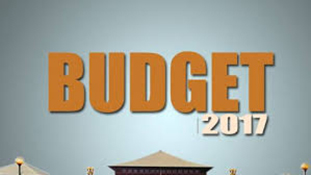Highlights
In the last two and half years administration has moved from discretionary, favouritism based to system and transparency based.
Inflation brought under control. CPI-based inflation declined from 6% in
July 2016 to 3.4% in December, 2016
Economy has moved on a high growth path. India’s Current Account Deficit declined from about 1% of GDP last year to 0.3% of GDP in the first half of 2016-17.
FDI grew 36% in H1 2016-17 over H1 2015-16, despite 5% reduction in global FDI inflows. Foreign exchange reserves have reached 361 billion US Dollars as on 20th January, 2017
War against black money launched
Government continued on path of fiscal consolidation, without compromising on public investment.
The Indian economy has been robust to mild shocks and IMF forecasts, India to be one of the fastest growing major economies in 2017.
In Budget 2017-18 the rate of taxation has been reduced from existing 10 per cent to 5 per cent for individual assesses between income of Rs 2.5 lakhs to Rs 5 lakhs. This would reduce the tax liability of all persons below Rs 5 lakh income either to zero (with rebate) or 50 per cent of their existing liability.
Social Sector
Last year for MGNREGA (2016-17)Rs. 38,500 crore was allotted, Now, 48,000 (2017-18) crore was allotted. This is the highest allocation since its inception in 2006. The new budget proposes of using space technology in a big way to plan & execution MGNREGA works.
In the last budget Government has proposed to launch a new initiative to provide cooking gas to BPL families with state support and set the target of giving 5crore connection under this inititive. By February 4, under the initiative called ‘Pradhan Mantri Ujjwala Yojana’ government has released 1, 66, 86,876(One crore sixty-six lakhs eighty-six thousands eight hundred seventy six) gas connections.
The budget 2017-18 proposes a hike of 8000 crore in Pradhan mantra Awas Yojana-Gramin(rural) from 15,000 crore in 2016-17 to 23,000 crore in 2017-18, which aims to build 10 million homes by 2019 for those without a house of their own and those living in mud houses.
The Government in the budget has proposed to increase the allocations for Deendayal Antyodaya Yojana- National Rural Livelihood Mission for promotion of skill development and livelihood opportunities for people in rural areas to Rs 4,500 crore in 2017-18.
The allocation for Prime Minister’s Employment Generation Programme (PMEGP) and Credit Support Schemes has been increased more than 3 times.
The Swachh Bharat Mission (Gramin) has made tremendous progress in promoting safe sanitation and ending open defecation. Sanitation coverage in rural India has gone up from 42% in October 2014 to about 60% and such villages are now being given priority for piped water supply.
There is provision in the budget for imparting new skills to the people in the rural areas, mason training will be provided to 5 lakh persons by 2022, with an immediate target of training at least 20,000 persons by 2017-18.
Agriculture
The coverage of National Agricultural Market (e-NAM) will be expanded from the current 250 markets to 585 APMCs.
The coverage of Fasal Bima Yojana will be increased from 30% of cropped area in 2016-17 to 40% in 2017-18 and 50% in 2018-19.
Issuance of Soil Health Cards has gathered momentum. Till 31 January 2017 Government has issued 5 crore 5 lakh 9 thousand four hundred ninety-five (5,05,09,495) cards. The Government has decided to set-up new mini labs in Krishi Vigyan Kendras (KVKs) and ensure 100% coverage of all 648 KVKs in the country.
The pace of construction of Pradhan Mantri Gram Sadak Yojana, (PMGSY) roads has accelerated to reach 133 km roads per day in 2016-17, as against an average of 73 km during the period 2011-2014. The Government is committed to complete the current target under PMGSY by 2019 and a sum of Rs 19,000 crore has been provided in 2017-18 for this scheme.
Infrastructure
The total allocation for infrastructure development in 2017-18 stands at Rs. 3,96,135 crores. In the road sector, the Budget allocation has been stepped up for Highways from Rs. 57,976 crores in BE 2016-17 to Rs. 64,900 crores in 2017-18. Further, 2,000 kms of coastal connectivity roads have been identified for construction and development to facilitate better connectivity with ports and remote villages.
The finance minister budget speech discloses that the total length of roads, including those under Pradhan Mantri Gram Sadak Yojana (PMGSY), built from 2014-15 till the current year is about 1,40,000 kms which is significantly higher than previous three years.
The recent spectrum auctions have removed spectrum scarcity in the country. For the BharatNet Project, the allocation has been stepped up to Rs.10,000 crores in 2017-18 and 1,55,000 kms of Optical Fiber Cables have been laid. By the end of 2017-18, high speed broadband connectivity on optical fiber will be available in more than 1,50,000 gram panchayats, with wifi hot spots and access to digital services at low tariffs. A DigiGaon initiative will be launched to provide tele-medicine, education and skills through digital technology.
For strengthening Energy sector, in the budget the Government has decided to set up Strategic Crude Oil Reserves. In the first phase, 3 such Reserve facilities have been set up and in the second phase, it is proposed to set up caverns at 2 more locations, namely, Chandikhole in Odisha and Bikaner in Rajasthan. This will take the country’s strategic reserve capacity to 15.33 MMT.
Defence
In 2016-17 budget Defence allocation was 2.46 lakh crore. Now The 2017-18 budget defence allocation has been increased to 2.74 lakh crore.
(Compiled by- Vikash Anand)
vikashanand@kamalsandesh.org


